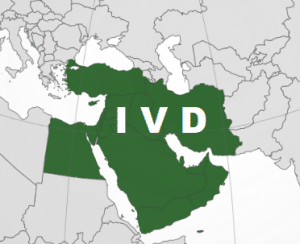What is The Size of the IVD Market in the Middle East?
In the IVD industry, emerging markets are currently the major source of market growth. Opportunity for innovation, as well, exists in emerging markets, where acceleration of new products is the largest mid- to long-term driver of value.
In the Middle East, with increased demand for healthcare has come increased access to it. In the 1970s, many countries in the Middle East and the Gulf countries started down a path of providing public healthcare to citizens. Countries such as, Oman, Saudi Arabia, Qatar, Iraq, Syria and Turkey all have universal healthcare programs.
The Middle East market for diagnostics is estimated at $2,850 million in 2018 and is expected to grow 5.7% annually to $3,750 million by 2023. According to a Kalorama Information’s report on IVD in the Middle East
This development requires increased investment in healthcare. This increased investment most often takes the form of government tenders, which remain a major source of supply for state-controlled labs and hospitals.

In the Middle East, lifestyle change a more sedentary lifestyle resulting in rising obesity rates has brought about the emergence of “Western” diseases such as diabetes. There is growing demand in the region, therefore, for medical tests.
The Middle East remains an underserved region with large market potential.
IVD manufacturers can expect solid growth in developing countries, especially in Brazil, China, countries in Southeast Asia and the Middle East (ME). But even in emerging markets, growth has slowed from earlier average annual growth figures of 20%.
Some of the total IVD market growth derives from increased test usage in emerging countries. All of the major IVD companies have reported growth in Turkey and Saudi Arabia, considered two of the top seven emerging markets. These countries continue to invest in healthcare infrastructure and insurance coverage for a growing more affluent middle class.
IVD manufacturers can also expect new availability of tests and test systems designed for use in resource poor settings worldwide; increased consolidation of healthcare services throughout the world, developed and emerging economies included, and thus increased pricing pressure on all medical devices, including IVDs; and increased availability of healthcare insurance in emerging countries, providing an opportunity for expansion of the IVD market to serve the growth in people who have access to healthcare services and testing.
The countries in this region include:
• Egypt
• Iran
• Iraq
• Israel
• Jordan
• Saudi Arabia
• Turkey
• United Arab Emirates (UAE)
• Other Mideast (Bahrain, Cyprus, Gaza Strip, Kuwait, Lebanon, Oman, Qatar, Syria, West Bank, Yemen)
The next five to ten years will see moderate and gradual change in global in vitro diagnostic (IVD) product markets. While clinical lab medicine plays an integral role in healthcare and disease management, new testing is difficult to launch in a time of global economic instability and rising healthcare costs. On the supply side, labs are challenged to add new tests with little increase in financial and human resources.
IVD companies are casting their nets in developing countries, where rising incomes and standards of living have sparked a new health consciousness and growing demands for quality medical care.
IVD manufacturers can expect solid growth in developing countries, especially in Brazil, China, countries in Southeast Asia and the Middle East (ME). But even in emerging markets, growth has slowed from earlier average annual growth figures of 20%.
Some of the total IVD market growth derives from increased test usage in emerging countries. All of the major IVD companies have reported growth in Turkey and Saudi Arabia, considered two of the top seven emerging markets. These countries continue to invest in healthcare infrastructure and insurance coverage for a growing more affluent middle class.
IVD manufacturers can also expect new availability of tests and test systems designed for use in resource poor settings worldwide; increased consolidation of healthcare services throughout the world, developed and emerging economies included, and thus increased pricing pressure on all medical devices, including IVDs; and increased availability of healthcare insurance in emerging countries, providing an opportunity for expansion of the IVD market to serve the growth in people who have access to healthcare.

